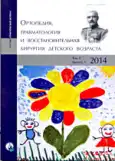ОСОБЕННОСТИ ТЕЧЕНИЯ ВРОЖДЕННЫХ ЛОЖНЫХ СУСТАВОВ КОСТЕЙ ГОЛЕНИ У ДЕТЕЙ ДИСТРОФИЧЕСКОГО И ДИСПЛАСТИЧЕСКОГО ГЕНЕЗА
- Авторы: Поздеев А.П.1, Захарьян Е.А.2
-
Учреждения:
- ФГБУ «НИДОИ им. Г. И. Турнера» Минздрава России
- ГБОУ ВПО «СЗГМУ им. И. И. Мечникова» Минздрава России
- Выпуск: Том 2, № 1 (2014)
- Страницы: 78-84
- Раздел: Статьи
- Статья получена: 15.01.2015
- Статья опубликована: 15.03.2014
- URL: https://journals.eco-vector.com/turner/article/view/269
- DOI: https://doi.org/10.17816/PTORS2178-84
- ID: 269
Цитировать
Полный текст
Аннотация
The purpose of study was to refine frequency of etiological factors and characteristics of congenital pseudarthrosis of tibia (CPT). Materials and Methods. The analysis of complex research (anamnestic, clinical, radiological, physiological, morphological) of 190 patients with CPT. Results. It was found that the causes of disease are: neurofibromatosis, myelodysplasia and fibrous dysplasia. In neurofibromatosis and myelodysplasia in the basis for false joints there are neurotrophic disorders. Typically a latent pseudarthrosis occurs at birth with the progression of deformity and thinning of the affected bone. Provoking factor of pseudarthrosis is a pathological fracture. Deformities, limb shortening, significant thinning and sclerosis of ends of bone fragments, degenerative changes in bone tissue throughout the diaphysis and epiphysis, lowered bone growth, weak ossification at the ends of bone fragments up to complete absence are observed. In fibrous dysplasia the provoking factor is a pathological fracture. The ends of the bone fragments are thickened, sclerotic, they reveal foci of fibrous dysplasia. Conclusion. It was found that two groups of CPT are: neurotrophic and dysplastic types. Neurotrophic CPT develops against neurofibromatosis and myelodysplasia, dysplasric one - against fibrous dysplasia. Features of the development and course of congenital pseudarthrosis of tibia have a direct correlation with the etiologic factor.
Об авторах
Александр Павлович Поздеев
ФГБУ «НИДОИ им. Г. И. Турнера» Минздрава России
Email: prof.pozdeev@mail.ru
д. м. н., профессор, главный научный сотрудник отделения костной патологии
Екатерина Анатольевна Захарьян
ГБОУ ВПО «СЗГМУ им. И. И. Мечникова» Минздрава России
Email: zax-2008@mail.ru
аспирант кафедры детской ортопедии и травматологии
Список литературы
- Поздеев А. П., Андрианов В. Л. Врожденные пороки развития голени // Травматология и ортопедия: рук. для врачей. В 3 т. М.: Медицина, 1997. С. 290-306.
- Гук Ю. Н. Поражение опорно-двигательного аппарата при нейрофиброматозе у детей и подростков // Материалы VI съезда травматологов-ортопе-дов СНГ. Ярославль, 1993.
- Шанц А. Практическая ортопедия. М.: Государственное медицинское издательство, 1933. 564 с.
- Майсурадзе Р. Г. Врожденные ложные суставы костей голени у детей и подростков [Текст]: (патогенез, клиника, лечение): Автореф. дис.. канд. мед. наук: 14.00.22; ЦНИИ травматологии и ортопедии им. Н. Н. Приорова. М., 1981. 27 с. Библиогр.: С. 26-27.
- Поздеев А. П., Садофьева В. И. Классификация ложных суставов и дефектов костей у детей. Патология крупных суставов и другие актуальные вопросы детской травматологии и ортопедии. СПб., 1998. С. 22-25.
- Поздеев А. П. Ложные суставы и дефекты костей у детей (Этиология, клиника, лечение): Дис.. док. мед. наук. СПб., 1998.
- Трофимова Т. Н., Парижский З. М. Корифей отечественной рентгенологии - Самуил Аронович Рейнберг (ленинградский период деятельности) // Радиология - практика. 2006. № 1.
- Шевцов В. И., Борзунов Д. Ю., Митрофанов А. И. Стимуляция регенерации костной ткани в полостных дефектах при лечении пациентов с опухолеподобными поражениями длинных костей // Гений ортопедии. 2009. № 1. С. 107-109.
- Khiamia F., Rampalb V., Seringe R. Congenital pseudarthrosis of the tibia: An atypical proximal location Orthopaedics & Traumatology // Surgery & Research. 2010. 96, 70-74.
- Pannier S. Congenital pseudarthrosis of the tibia Orthopaedics & Traumatology // Surgery & Research. 2011. 97, 750-761.
- Khan T., Joseph B. Controversies in the management of congenital pseudarthrosis of the tibia and Fibula // Bone Joint J. 2013; 95-B: 1027-34.
- Paget J. Ununited fractures in children. In: Paget’s studies of old case books. London: Longman’s Green & Co., 1891: 130-135.
- Heikkinen E. S., Poyhonen M. H., Kinnunen P. K. Congenital pseudarthrosis of the tibia: treatment and outcome at skeletal maturity in 10 children // Acta Orthop. Scand. 1999; 70: 275-282.
- Fairbank J. Orthopaedic manifestations of neurofibromatosis. In: Huson S. M., Hughes RAC, eds. The neurofibromatoses: a pathogenic and clinical overview. Cambridge: University Press, 1994: 275-303.
- Boyd H. B. Pathology and natural history of congenital pseudarthrosis of the tibia // Clin. Orthop. Relat. Res. 1982; 166: 5-13.
- Lee [et al.] Osteoblastic Differentiation in Congenital Pseudarthrosis Clinics in Orthopedic Surgery. Vol. 3. № 3. 2011. www.ecios.org
- Bressers M. M., Castelein R. M. Anterolateral tibial bowing and duplication of the hallux: a rare but distinct entity with good prognosis // J. Pediatr. Orthop. B. 2001; 10: 153-157.
- Teo H. E., Peh W. C., Akhilesh M., Tan S. B., Ishida T. Congenital osteofibrous dysplasia associated with pseudoarthrosis of the tibia and fibula // Skeletal Radiol. 2007; 36(Suppl): S7-14.
- Sakamoto A., Yoshida T., Yamamoto H. [et al.] Congenital pseudarthrosis of the tibia: analysis of the histology and the NF1 gene // J. Orthop. Sci. 2007; 12: 361-365.
Дополнительные файлы








